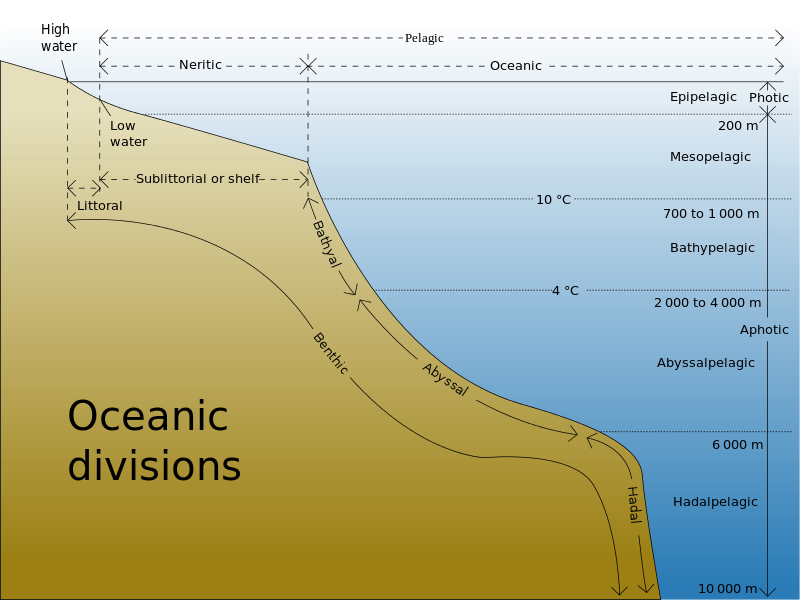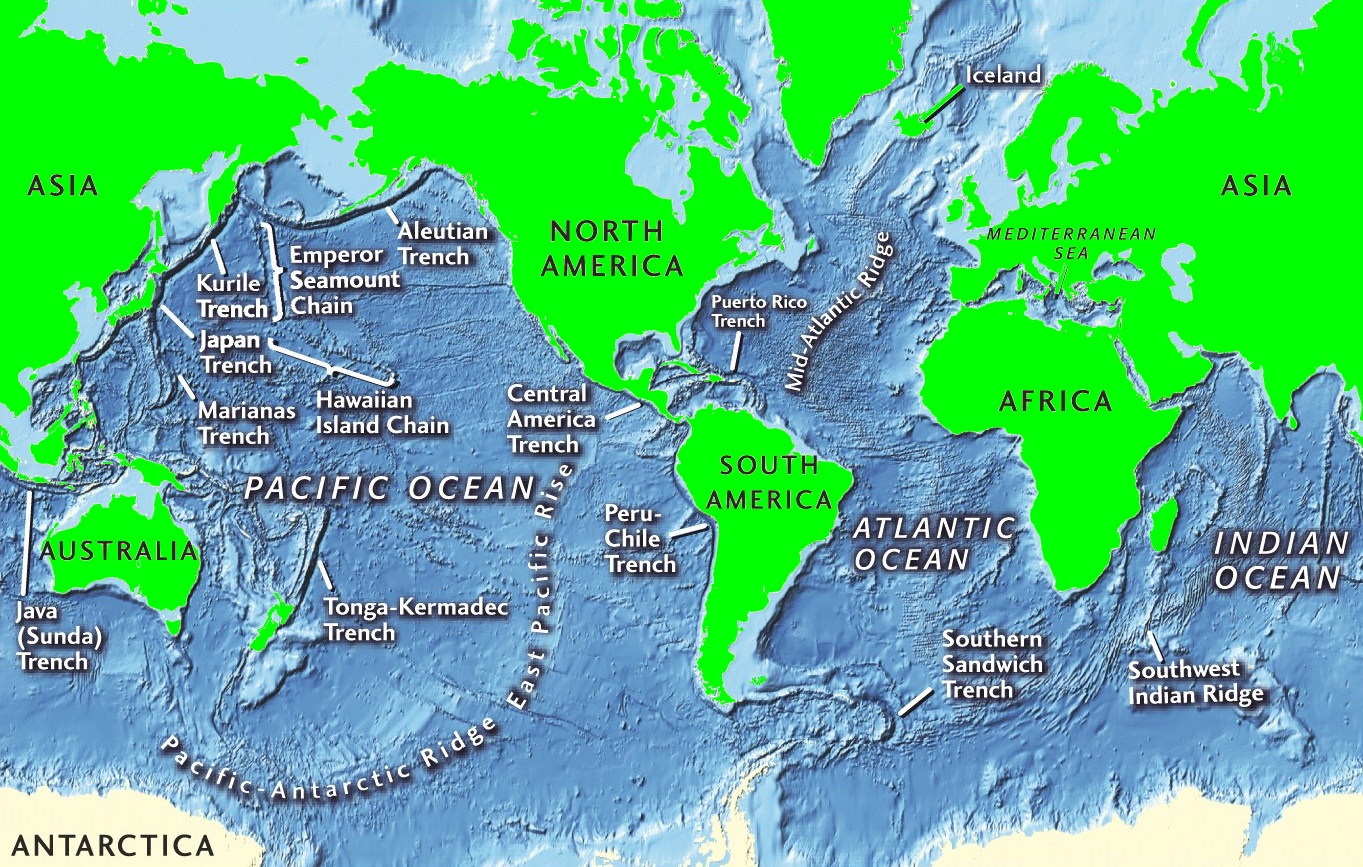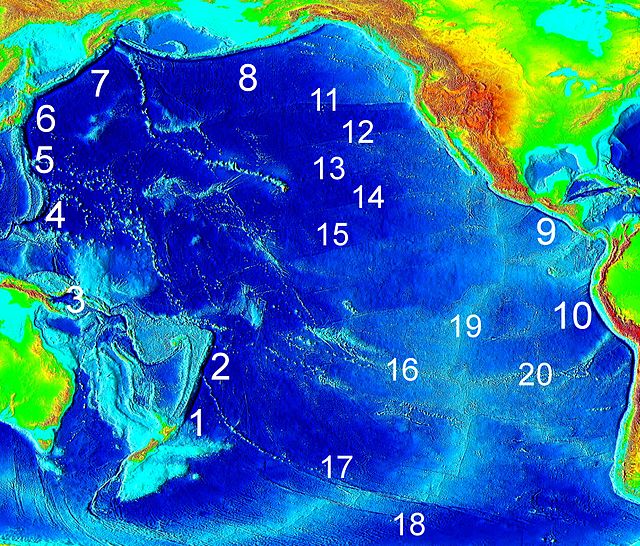
The epipelagic (euphotic) zone - also called the sunlit zone, receives enough sunlight to support photosynthesis. The temperatures in this zone range anywhere from 40 to −3 °C. The epipelagic zone is the one closest to the surface and is the best lit. It extends to 200 metres and contains both phytoplankton and zooplankton that can support larger organisms like marine mammals and some types of fish. This is the top layer, nearest the surface. Here there is enough light penetrating the water to support photosynthesis. More than ninety percent of all marine life lives in the sunlit zone. The sunlit zone goes down about 600 metres. Most fish and other sentient races live in this zone.
The mesopelagic (disphotic) zone - where only small amounts of light penetrate, lies below the epipelagic zone. This zone is often referred to at the Twilight Zone due to its scarce amount of light. Temperatures in the mesopelagic zone range from 5 to 4 °C. The pressure is higher here, it can be up to 1,470 pounds per square inch (10,100,000 Pa) and increases with depth. Only a small amount of light can penetrate the water at this depth. As the water becomes deeper, the pressure also increases. Plants do not grow here. Only animals that have adapted to low light survive. The nommo and the Cerulean nixie call this zone home. This gloomy part of the ocean begins at about 600 metres under the water and extends to the darkest part, which begins about 3000 metres down. Bioluminescent creatures abound in this zone.
The bathypelagic (aphotic) zone - 90% of the ocean lies here in which no light penetrates. This is also called the midnight zone. Water pressure is very intense and the temperatures are near freezing range 0 to 6 °C. It is oppressively dark, the water pressure is extreme, and the temperature is near freezing. Living creatures found here live close to cracks in the planet's crust. These cracks give off mineral-rich materials that nourish bacteria, which form the bottom of the food chain here, much like plankton does in the waters above. Deep drow, the aquatic equivalent of the surface dark elves, claim this realm as their own.
Past 200 metres, not enough light penetrates the
water to support life, and no plant life exists.
There are creatures however, which thrive around hydrothermal vents, or geysers
located on the ocean floor that expel super heated water that is rich in
minerals. These organisms feed off of chemosynthetic bacteria, which use the
super heated water and chemicals from the hydrothermal vents to create energy in
place of photosynthesis. The existence of these bacteria allow creatures like
squids, hatchet fish, octopuses, tube worms, giant clams, spider crabs and other
organisms to survive.
Due to the total darkness in the zones past the epipelagic zone, many organisms
that survive in the deep oceans do not have eyes, and other organisms make their
own light with bioluminescence. Often the light is blue green in colour, because
many marine organisms are sensitive to blue light. Two chemicals, luciferin and
luciferase that react with one another to create a soft glow. The process by
which bioluminescence is created is very similar to what happens when a glow
stick is broken. Deep-sea organisms use bioluminescence for everything from
luring prey to navigation.
Animals such as fishes, whales, and sharks are found in the oceanic zone.
The ocean floor is not as flat and sandy as their more-familiar beaches, nor
quite so predictable. In addition to the aquatic mountains, valleys, deserts,
and plains, there are features that are foreign to those that live solely on
land.
As the land descends beneath the sea, there are drastic changes in the planet's
geology. This transitional area, known as the continental margin, includes both
the continental shelf and the continental slope. As dry-land fades from sight,
the heavy and thick continental granite gives way to a thinner layer of basalt.
The continental shelf normally contains water that is only a couple of hundred
metres deep. The neritic zone is located here. The width of the continental shelf
varies greatly depending on location. At the edge of the continental shelf, the
ocean floor begins a steep descent known as the continental slope. This area is
often pervaded by fathomless submarine canyons.
The slope levels out at the ocean basin, which also has some interesting
features. Perhaps the most unusual are the abyssal plains which are large, flat
areas on the ocean floor covered with a thick layer of sediment and decomposing
organic ooze. Large, undersea volcanoes called seamounts occasionally rise from
these depths. Sometimes the peaks of these giant underwater volcanoes reach to
the surface to form volcanic islands.
Ocean trenches are found along the edge of ocean basins. These trenches contain
the deepest parts of the ocean, and therefore, the deepest parts of the world.
They can go down several kilometres, and are known to harbor the most terrible
abominations that one could imagine.
In contrast to terrestrial habitats, marine habitats are shifting and ephemeral.
Swimming organisms find areas by the edge of a continental shelf a good habitat,
but only while upwellings bring nutrient rich water to the surface. Shellfish
find habitat on sandy beaches, but storms, tides and currents mean their habitat
continually reinvents itself.
The presence of seawater is common to all marine habitats. Beyond that many
other things determine whether a marine area makes a good habitat and the type
of habitat it makes. For example:
Temperature – is affected by geographical latitude, ocean currents, weather, the
discharge of rivers, and by the presence of hydrothermal vents or cold seeps.
Sunlight – photosynthetic processes depend on how deep and turbid the water is.
Nutrients – are transported by ocean currents to different marine habitats from
land runoff, or by upwellings from the deep sea, or they sink though the sea as
marine snow.
Salinity – varies, particularly in estuaries or near river deltas, or by hydrothermal vents.
Dissolved Gases – oxygen levels in particular, can be increased by wave actions
and decreased during algal blooms.
Acidity – this is partly to do with dissolved gases above, since the acidity of
the ocean is largely controlled by how much carbon dioxide is in the water.
Turbulence – ocean waves, fast currents and the agitation of water affect the
nature of habitats.
Cover – the availability of cover such as the adjacency of the sea bottom, or
the presence of floating objects
the occupying organisms themselves since organisms modify their habitats by
the act of occupying them, and some, like corals, kelp, mangroves and
seagrasses, create further habitats for other organisms.

The pelagic part of the aphotic zone can be further
divided into vertical regions according to temperature. The mesopelagic is
the uppermost region. Its lowermost boundary is at a thermocline of 12 °C,
which, in the tropics generally lies at 700–1000 metres. Next is the
bathypelagic lying between 10 and 4 °C, typically between 700–1000 metres
and 2,000–4,000 metres. Lying along the top of the abyssal plain is the
abyssopelagic, whose lower boundary lies at about 6,000 metres. The last
zone includes the deep oceanic trench, and is known as the hadalpelagic.
This lies between 6,000–11,000 metres and is the deepest oceanic zone. The
benthic zones are aphotic and correspond to the three deepest zones of the
deep-sea. The bathyal zone covers the continental slope down to about 4000
metres. The abyssal zone covers the abyssal plains between 4000 and 6000 m.
Lastly, the hadal zone corresponds to the hadalpelagic zone, which is found
in oceanic trenches.
The pelagic zone can be further subdivided into two subregions: the neritic
zone and the oceanic zone. The neritic zone encompasses the water mass
directly above the continental shelves whereas the oceanic zone includes all
the completely open water.
In contrast, the littoral zone covers the region between low and high tide
and represents the transitional area between marine and terrestrial
conditions. It is also known as the intertidal zone because it is the area
where tide level affects the conditions of the region.
The ocean can be divided into three density zones: the surface zone, the pycnocline, and the deep zone. The surface zone, also called the mixed layer, refers to the uppermost density zone of the ocean. Temperature and salinity are relatively constant with depth in this zone due to currents and wave action. The surface zone contains ocean water that is in contact with the atmosphere and within the photic zone. The surface zone has the ocean's least dense water and represents approximately 2% of the total volume of ocean water. The surface zone usually ranges between depths of 150 to 1000 metres below ocean surface, but this can vary a great deal. In some cases, the surface zone can be entirely non-existent. The surface zone is typically thicker in the tropics than in regions of higher latitude. The transition to colder, denser water is more abrupt in the tropics than in regions of higher latitudes. The pycnocline refers to a zone wherein density substantially increases with depth due primarily to decreases in temperature. The pycnocline effectively separates the lower-density surface zone above from the higher-density deep zone below. The pycnocline represents approximately 18% of the total volume of ocean water. The deep zone refers to the lowermost density zone of the ocean. The deep zone usually begins at depths below 1 kilometre in mid-latitudes. The deep zone undergoes negligible changes in water density with depth. The deep zone represents approximately 80% of the total volume of ocean water. The deep zone contains relatively colder and stable water. If a zone undergoes dramatic changes in temperature with depth, it contains a thermocline. The tropical thermocline is typically deeper than the thermocline at higher latitudes. Polar waters, which receive relatively little solar energy, are not stratified by temperature and generally lack a thermocline because surface water at polar latitudes are nearly as cold as water at greater depths. Below the thermocline, water is very cold, ranging from −1 °C to 3 °C. Because this deep and cold layer contains the bulk of ocean water, the average temperature of the world ocean is 3.9 °C. If a zone undergoes dramatic changes in salinity with depth, it contains a halocline. If a zone undergoes a strong, vertical chemistry gradient with depth, it contains a chemocline. The halocline often coincides with the thermocline, and the combination produces a pronounced pycnocline.

